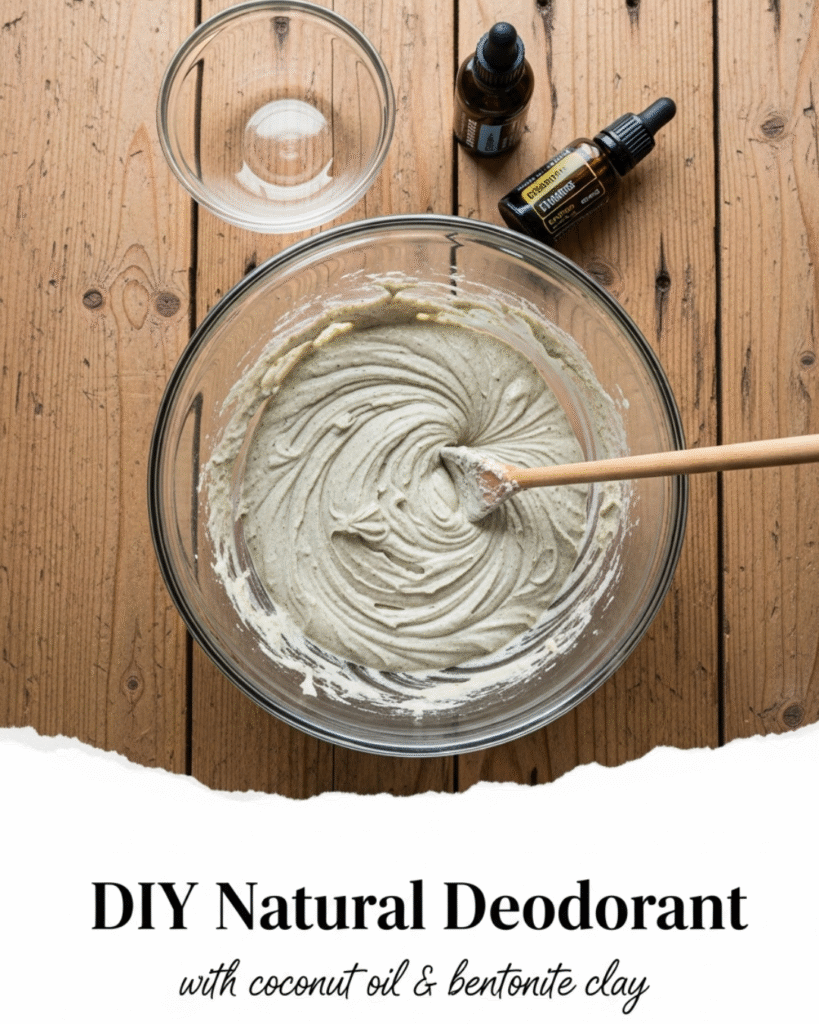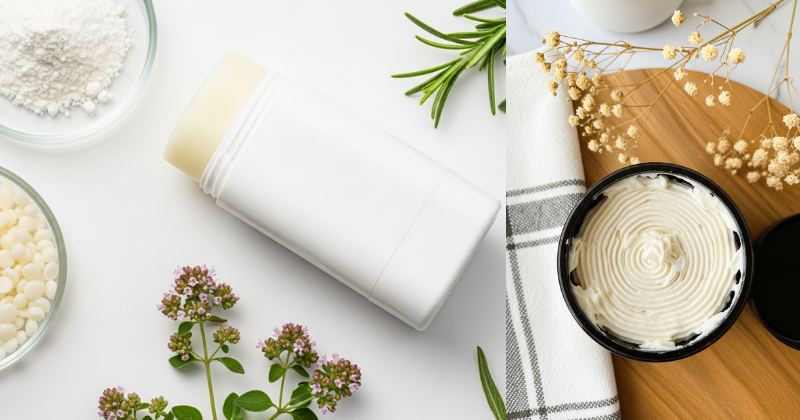Tired of questionable ingredients in your daily hygiene products and ready for a genuinely fresh start? Learning how to make DIY natural deodorant is an achievable process that promises comfort, freshness, and the satisfaction of total ingredient control. We’ll show you how to transform your underarm care using the powerful combination of coconut oil & bentonite clay—a formula that works! This guide focuses on sustainable lifestyle changes, providing step-by-step guidance and scientific backing to help you discover your new favorite, chemical-free deodorant.
Important Disclaimer: This article is for informational purposes only and should not replace professional advice. For health-related topics, consult healthcare providers. Individual results may vary, and personal circumstances should always be considered when implementing any suggestions.

🧪 Foundation First: Why Switch to DIY Natural Deodorant?
Making the switch from conventional antiperspirants to DIY natural deodorant can feel like a big leap, but understanding the scientific difference between deodorants and antiperspirants, and the benefits of a simple, clean formula, will build confidence.
H3: Building Confidence with Basic Concepts
- Deodorant vs. Antiperspirant: Antiperspirants use aluminum compounds (like aluminum chlorohydrate) to physically plug your sweat ducts and stop the body’s natural sweating process. Deodorants, including our DIY natural deodorant, work differently—they don’t stop sweating (which is a necessary cooling and detoxification process) but instead neutralize the odor-causing bacteria.
- The Power of Bentonite Clay: This is the secret weapon in our formula. Bentonite clay is an absorbent volcanic ash that has a negative electrical charge. When mixed with water (or sweat), it swells and acts like a magnet, drawing out toxins and impurities from the skin. It helps absorb some moisture while also acting as a mild purifier.
- Encouraging Reassurance for Beginners: The transition period can involve temporary increased odor or moisture as your body purges impurities and adjusts. This is normal! Be supportive of your body during this gradual progress.
H3: Addressing Common Concerns: The Baking Soda Question
Many popular DIY deodorant recipes use baking soda (sodium bicarbonate), which is a fantastic odor absorber, but it frequently causes irritation and redness.
- Baking Soda Alternative: Our primary focus is on coconut oil & bentonite clay. Bentonite clay, along with starches like arrowroot powder, provides the necessary absorbency and texture without the high $\text{pH}$ level of baking soda, making this a gentler, more soothing formula suitable for sensitive skin. We use baking soda sparingly, if at all, offering an alternative approach for those with high sensitivity.
✨ Section 2: Core Methods: The Coconut Oil & Bentonite Clay Recipe
This recipe is simple, effective, and focuses on achievable, step-by-step guidance. This formula yields a soft, spreadable paste perfect for application from a tin or jar.
The Ingredients (Cost-Saving Benefits Focus)
These ingredients are common, inexpensive, and readily available online or in health food stores.
- Coconut Oil (Solid): $\frac{1}{2}$ cup (Provides moisturizing base and structure, known for its antibacterial properties.)
- Bentonite Clay: $\frac{1}{4}$ cup (Odor neutralization and moisture absorption.)
- Arrowroot Powder (or Cornstarch): $\frac{1}{4}$ cup (Moisture absorption and texture.)
- Beeswax Pellets (Optional for firmness): 1 tablespoon (Highly recommended for stability, especially in warmer climates.)
- Essential Oils (Tea Tree and Lavender): $10-15$ drops total (For scent and added antibacterial/antifungal benefits.)
Step-by-Step Preparation (Clear, Actionable Language)
- Melt the Base: Place the coconut oil and beeswax (if using) into a double boiler or a glass jar placed in a pot of simmering water. Heat gently until fully melted and clear. Safety considerations: Use low heat; high heat can diminish the beneficial properties of the oil.
- Mix the Dry Ingredients: In a separate, non-metal bowl (bentonite clay should not touch metal, which can reduce its efficacy), thoroughly whisk together the bentonite clay and arrowroot powder until lump-free.
- Combine Wet and Dry: Pour the melted coconut oil and beeswax mixture into the bowl with the dry powders. Stir well with a wooden or silicone spoon until the consistency is smooth, like a thick lotion.
- Add Essential Oils: Once the mixture has cooled slightly (but is still liquid), stir in your chosen $10-15$ drops of essential oils. Internal Linking Opportunity: Find out the best combinations in our guide, “Choosing Safe Essential Oils for Skincare.”)
- Pour and Cool: Immediately pour the liquid DIY natural deodorant mixture into sterilized glass jars, tins, or empty, cleaned deodorant sticks.
- Setting (Timing and Planning Considerations): Allow the deodorant to cool and solidify completely at room temperature or in the refrigerator for 2-3 hours. Once solid, cover and store.
🛠️ Section 3: Advanced Strategies: Customizing for Your Lifestyle
Ready to move beyond the basic recipe? These pro tips help you customize your DIY natural deodorant for scent, climate, and sensitivity.
H3: Creative Solutions for Firmness and Application
- The Stick Method: To create a traditional deodorant stick, you must increase the firmness. Use 2 tablespoons of Beeswax instead of 1 tablespoon in the recipe above. This provides the structure needed to keep the stick firm, even when you apply pressure.
- Sensitive Skin Adjustment: If you still experience any mild redness, replace $\frac{1}{2}$ of the bentonite clay with zinc oxide (a non-nano, cosmetic grade) or pure kaolin clay. Zinc oxide is incredibly soothing and is an effective odor neutralizer. This provides a direct way to customize approach based on your body’s needs.
H3: Seasonal Adaptations for Climate Control
Coconut oil’s melting point is around $76^\circ\text{F}$ ($24^\circ\text{C}$), which can be problematic in warm climates or during summer.
- Summer Formula Pro Tip: For hot seasonal considerations, increase both the Beeswax and the Arrowroot Powder by $1$ tablespoon each. This significantly raises the melting point and absorbency, ensuring your DIY natural deodorant holds its shape when you need it most.
- Winter Formula: If you find the balm too hard to scoop in cold weather, decrease the beeswax to $\frac{1}{2}$ tablespoon and add a softer butter, like mango or shea butter ($1$ tablespoon), to maintain a creamy texture.
🛑 Section 4: Troubleshooting Common Challenges
Transitioning to natural deodorant, especially a DIY version, often comes with a few predictable hiccups. Don’t be discouraged; solutions are simple!
Featured Snippet Potential: “What is the best way to apply natural deodorant paste?”
The best way to apply natural deodorant paste is to scoop a small, pea-sized amount onto your fingertip, rub it briefly between your hands to soften and warm the paste, and then gently massage it into the entire underarm area until fully absorbed. Ensure your underarms are completely dry before application for maximum effectiveness.
Practical Troubleshooting Tips (Wellness Focus)
- Problem: Experiencing itchiness or a mild rash.
- Obstacle: You might be sensitive to the essential oils or, possibly, the bentonite clay is causing temporary dryness.
- Solution: Encouragement for setbacks: Stop using the deodorant for a few days. Once the skin heals, try a new batch with no essential oils, or switch to kaolin clay instead of bentonite. If the rash persists, consult a dermatologist.
- Problem: The deodorant is too gritty or separates over time.
- Obstacle: The powders (clay and arrowroot) were not whisked sufficiently into the liquid oil, or the balm was poured too hot.
- Solution: Re-melt the entire batch slowly. This time, ensure you are whisking constantly while pouring the melted oil into the powders, and continue stirring as the mixture cools until it begins to thicken, preventing the heavy powders from settling.
- Problem: Noticeable odor breakthrough by midday.
- Solution: Preventive measures: Your body might still be detoxing, or your application amount is too small. Apply generously and ensure your armpits are clean before application. Consider adding a few more drops of Tea Tree essential oil, which offers powerful antibacterial action.
🚀 Section 5: Maximizing Results: The Detox and Beyond
To truly benefit from your DIY natural deodorant, you need to ensure your underarms are ready to receive the product. This focuses on maintenance and long-term considerations.
- Underarm Detox: Before starting, perform an underarm “detox” to clear out built-up aluminum residue and product buildup. Mix 1 tablespoon of bentonite clay with 1 teaspoon of apple cider vinegar and a splash of water to form a paste. Apply it to your underarms for 10-20 minutes, then rinse. Repeat this 3-4 times over the first two weeks of switching.
- Complementary Strategies: Shaving can create microscopic cuts, increasing sensitivity. Try trimming hair instead of shaving completely, or save shaving for the evening so the skin can heal overnight before applying the coconut oil & bentonite clay deodorant in the morning.
- Inspire Continued Growth and Learning: Once you master this recipe, you can apply these DIY skills to other cosmetics! (Internal Linking Opportunity: See our next article, “Simple Homemade Body Butter with Shea Butter and Jojoba Oil.”) You have the capability to succeed at making all your own personal care products.
✅ Conclusion: Your Capability to Achieve Natural Wellness
You have successfully learned how to make DIY natural deodorant using the powerhouse combination of coconut oil & bentonite clay. By mastering this simple DIY technique, you’ve taken control of your wellness, embracing cost-saving benefits and eliminating unnecessary chemicals.
Remember to be patient during the transition—you are supporting your body’s natural process. Your dedication to sustainable lifestyle changes and self-care is empowering.
Which essential oil—the refreshing Peppermint or the soothing Lavender—will you use in your first customized batch to transform your daily routine?
